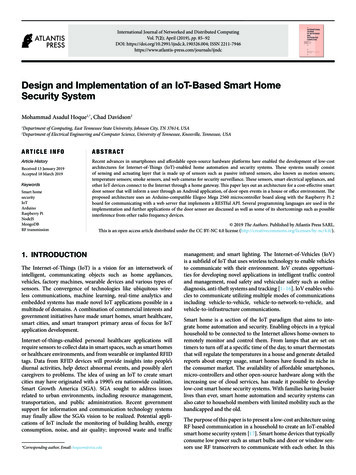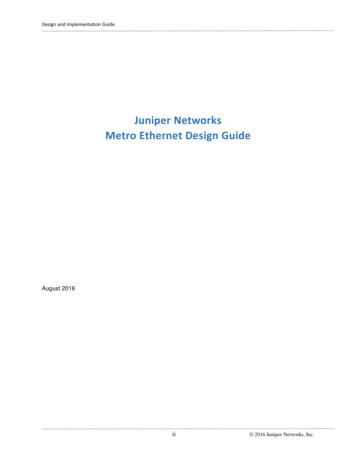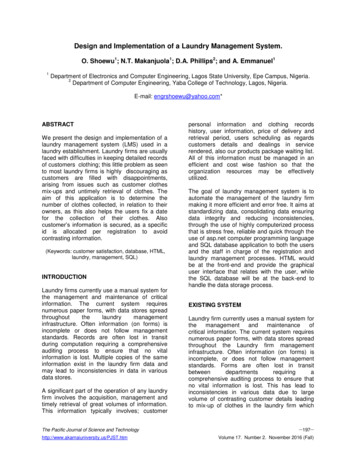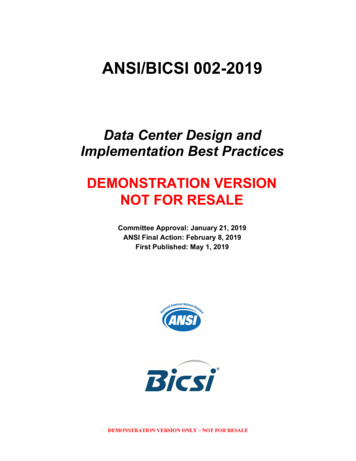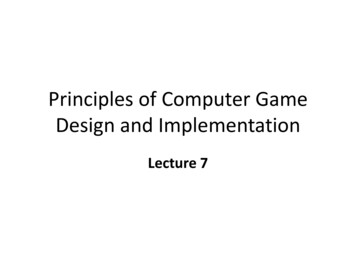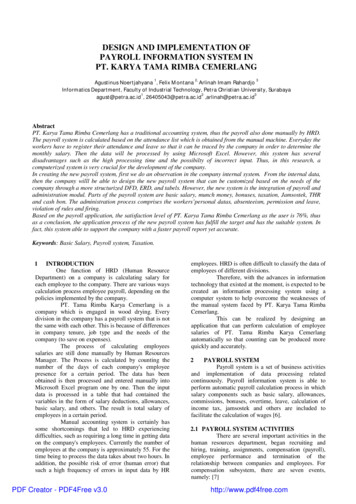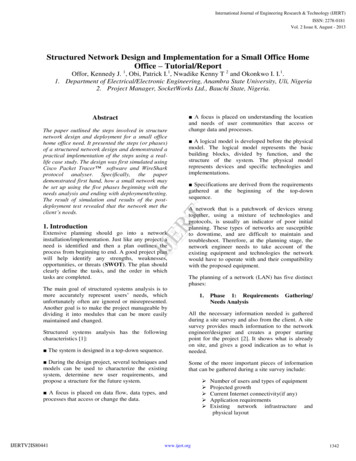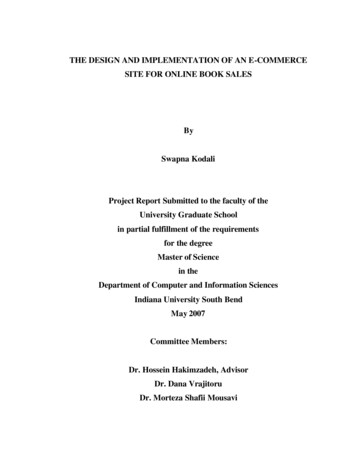
Transcription
THE DESIGN AND IMPLEMENTATION OF AN E-COMMERCESITE FOR ONLINE BOOK SALESBySwapna KodaliProject Report Submitted to the faculty of theUniversity Graduate Schoolin partial fulfillment of the requirementsfor the degreeMaster of Sciencein theDepartment of Computer and Information SciencesIndiana University South BendMay 2007Committee Members:Dr. Hossein Hakimzadeh, AdvisorDr. Dana VrajitoruDr. Morteza Shafii Mousavi
ii
2007Swapna KodaliAll Rights Reservediii
AbstractThe business-to-consumer aspect of electronic commerce (e-commerce) is themost visible business use of the World Wide Web. The primary goal of an e-commercesite is to sell goods and services online.This project deals with developing an e-commerce website for Online Book Sale.It provides the user with a catalog of different books available for purchase in the store.In order to facilitate online purchase a shopping cart is provided to the user. The systemis implemented using a 3-tier approach, with a backend database, a middle tier ofMicrosoft Internet Information Services (IIS) and ASP.NET, and a web browser as thefront end client.In order to develop an e-commerce website, a number of Technologies must bestudied and understood. These include multi-tiered architecture, server and client sidescripting techniques, implementation technologies such as ASP.NET, programminglanguage (such as C#, VB.NET), relational databases (such as MySQL, Access).This is a project with the objective to develop a basic website where a consumeris provided with a shopping cart application and also to know about the technologies usedto develop such an application.This document will discuss each of the underlying technologies to create andimplement an e-commerce website.iv
ACKNOWLEDGMENTSIn completing this graduate project I have been fortunate to have help, supportand encouragement from many people. I would like to acknowledge them for theircooperation.First, I would like to thank Dr.Hossein Hakimzadeh, my project advisor, forguiding me through each and every step of the process with knowledge and support.Thank you for your advice, guidance and assistance.I would also like to thank Dr.Shafii Mousavi and Dr.Dana Vrajitoru, my projectcommittee members, who showed immense patience and understanding throughout theproject and provided suggestions.Finally, I would like to dedicate this project to my parents, my husband Ram andmy friends Kumar and Soumya, for their love, encouragement and help throughout theproject.v
TABLE OF CONTENTS1. INTRODUCTION. 12. LITERATURE REVIEW . 13. PROJECT DESIGN. 33.1 DATA M ODEL . 43.1.1 Database Design. 63.2. PROCESS M ODEL . 103.2.1. Functional Decomposition Diagram. 103.2.2 Data Flow Diagram (DFD). 123.3 USER INTERFACE D ESIGN . 194. IMPLEMENTATION TECHNOLOGIES . 234.1. INTERNET INFORMATION S ERVICES (IIS) . 244.2 ASP.NET . 254.2.1. Authentication in ASP.NET . 264.3. M YSQL DATABASE . 274.4. INTEGRATING IIS AND ASP.NET . 284.5. INTEGRATING THE WEBSITE AND DATABASE. 295. WEB PAGE PROGRAMMING OPTIONS. 305.1. S ERVER -SIDE PROCESSING. . 315.2. CLIENT -SIDE PROCESSING. . 356. WEB BASED APPLICATION DEVELOPMENT. 367. DATABASE CONNECTIVITY . 387.1 ADO.NET. 387.2 CONNECTING ASP.NET APPLICATION TO A DATABASE. 458. THE SHOPPING CART APPLICATION . 468.1. S EARCH FOR BOOKS . 488.2. REGISTRATION . 498.3. USER D ETAILS . 508.4. SHOPPING CART . 518.5. PLACE AN ORDER . 528.6. CHECK O UT . 548.7. PURCHASE HISTORY. 568.8. TRANSACTIONS IN THE APPLICATION . 619. LIMITATIONS AND FUTURE DEVELOPMENT. 6510. CONCLUSION . 6511. BIBLIOGRAPHY. 67vi
LIST OF FIGURESFIGURE 1 ENTITY RELATIONSHIP DIAGRAM (ERD) . 4FIGURE 2 FUNCTIONAL DECOMPOSITION DIAGRAM. 11FIGURE 3 CUSTOMER - BROWSE CONTEXT DFD. 13FIGURE 4 CUSTOMER - BROWSE DETAILED DFD. 13FIGURE 5 CUSTOMER – SHOPPING CART CONTEXT DFD . 14FIGURE 6 CUSTOMER - SHOPPING CART DETAILED DFD. 14FIGURE 7 CUSTOMER - SHOPPING CART DETAILED DFD. 15FIGURE 8 CUSTOMER - SHOPPING CART DETAILED DFD. 15FIGURE 9 CUSTOMER – AUTHENTICATION – USERPROFILE DFD. 16FIGURE 10 AUTHENTICATED USER-PURCHASE CONTEXT DFD . 16FIGURE 11 CUSTOMER - AUTHENTICATION - PURCHASE DFD . 17FIGURE 12 CUSTOMER - NEW USERREGISTRATION DFD . 18FIGURE 13 ADMINSTRATOR CONTEXT DFD . 18FIGURE 14 ADMINISTRATOR DETAILED DFD . 18FIGURE 15 M ENU . 19FIGURE 16 DISPLAY OF BOOKS PRESENT IN THE STORE . 19FIGURE 17 FOR SEARCHING THE BOOKS IN THE STORE . 20FIGURE 18 SHOPPING CART FOR THE USER . 20FIGURE 19 REGISTRATION OF THE NEW USER . 21FIGURE 20 AUTHENTICATION OF THE USER . 22FIGURE 21 RELATION BETWEEN IIS AND ASP.NET. 23FIGURE 22 W EB PAGE PROGRAMMING OPTIONS . 30FIGURE 23 COMPILED SERVER PROGRAMS FLOWCHART . 31FIGURE 24 ADO.NET ARCHITECTURE . 43FIGURE 25 BOOK DETAILS . 47FIGURE 26 S ERACH FOR BOOKS . 48FIGURE 27 NEW USER REGISTRATION. 49FIGURE 28 USER DETAILS . 50FIGURE 29 SHOPPING CART . 51FIGURE 30 ORDER DETAILS . 52FIGURE 31SHIPPING DETAILS . 53FIGURE 32CHECK OUT . 54FIGURE 33 ORDER CONFIRMATION. 55FIGURE 34 UPDATED INVENTORY AFTER ORDER PLACEMENT . 55FIGURE 35 PURCHASE HISTORY. 56FIGURE 36 BOOK DETAILS . 57FIGURE 37 ADMINISTRATOR - MODIFY BOOKS . 58FIGURE 38 DETAILS ABOUT NEW BOOK . 59FIGURE 39 UPDATED INVENTORY . 60LIST OF TABLESTABLE 1PROCESSING TECHNOLOGY FOR DIFFERENT FILE EXTENSIONS . 33TABLE 2 TRANSACTION ATTRIBUTES . 64vii
1. IntroductionE-commerce is fast gaining ground as an accepted and used business paradigm.More and more business houses are implementing web sites providing functionality forperforming commercial transactions over the web. It is reasonable to say that the processof shopping on the web is becoming commonplace.The objective of this project is to develop a general purpose e-commerce storewhere any product (such as books, CDs, computers, mobile phones, electronic items, andhome appliances) can be bought from the comfort of home through the Internet.However, for implementation purposes, this paper will deal with an online book store.An online store is a virtual store on the Internet where customers can browse thecatalog and select products of interest. The selected items may be collected in a shoppingcart. At checkout time, the items in the shopping cart will be presented as an order. Atthat time, more information will be needed to complete the transaction. Usually, thecustomer will be asked to fill or select a billing address, a shipping address, a shippingoption, and payment information such as credit card number. An e- mail notification issent to the customer as soon as the order is placed.2. Literature ReviewElectronic Commerce (e-commerce) applications support the interaction betweendifferent parties participating in a commerce transaction via the network, as well as themanagement of the data involved in the process [2].The increasing importance of e-commerce is apparent in the study conducted byresearches at the GVU (Graphics, Visualization, and Usability) Center at the GeorgiaInstitute of Technology. In their summary of the findings from the eighth survey, theresearchers report that “e-commerce is taking off both in terms of the number of usersshopping as well as the total amount people are spending via Internet based transactions”.1
Over three quarters of the 10,000 respondents report having purchased items online. Themost cited reason for using the web for personal shopping was convenience (65%),followed by availability of vendor information (60%), no pressure form sales person(55%) and saving time (53%).Although the issue of security remains the primary reason why more people donot purchase items online, the GVA survey also indicates that faith in the security of ecommerce is increasing. As more people gain confidence in current encryptiontechnologies, more and more users can be expected to frequently purchase items online[11].A good e-commerce site should present the following factors to the customers forbetter usability [11]: Knowing when an item was saved or not saved in the shopping cart. Returning to different parts of the site after adding an item to the shopping cart. Easy scanning and selecting items in a list. Effective categorical organization of products. Simple navigation from home page to information and order links for specificproducts. Obvious shopping links or buttons. Minimal and effective security notifications or messages. Consistent layout of product information.Another important factor in the design of an e-commerce site is feedback [4]. Theinteractive cycle between a user and a web site is not complete until the web site respondsto a command entered by the user. According to Norman [5], "feedback--sending back tothe user informa tion about what action has actually been done, what result has beenaccomplished--is a well known concept in the science of control and information theory.Imagine trying to talk to someone when you cannot even hear your own voice, or tryingto draw a picture with a pencil that leaves no mark: there would be no feedback".2
Web site feedback often consists of a change in the visual or verbal informationpresented to the user. Simple examples include highlighting a selection made by the useror filling a field on a form based on a user's selection from a pull down list. Anotherexample is using the sound of a cash register to confirm that a product has been added toan electronic shopping cart.Completed orders should be acknowledged quickly. This may be done with anacknowledgment or fulfillment page. The amount of time it takes to generate anddownload this page, however, is a source of irritation for many e-commerce users. Usersare quick to attribute meaning to events. A blank page, or what a user perceives to be "along time" to receive an acknowledgment, may be interpreted as "there must besomething wrong with the order." If generating an acknowledgment may take longer thanwhat may be reasonably expected by the user, then the design should includeintermediate feedback to the user indicating the progress being made towardacknowledgment or fulfillment.Finally, feedback should not distract the user. Actions and reactions made by theweb site should be meaningful. Feedback should not draw the user's attention away fromthe important tasks of gathering information, selecting products, and placing orders.3. Project DesignIn order to design a web site, the relational database must be designed first.Conceptual design can be divided into two parts: The data model and the processmodel. The data model focuses on what data should be stored in the database while theprocess model deals with how the data is processed. To put this in the context of therelational database, the data model is used to design the relational tables. The processmodel is used to design the queries that will access and perform operations on thosetables.3
3.1 Data ModelA data model is a conceptual representation of the data structures that are requiredby a database. The first step in designing a database is to develop an Entity-RelationDiagram (ERD). The ERD serves as a blue print from which a relational database maybededuced. Figure 1 shows the ERD for the project and later we will show thetransformation from ERD to the Re lational model.Figure 1 Entity Relationship Diagram (ERD)In the ERD, a rectangle is used to represent a table and a diamond to represent therelationship between the entities. The cardinality is the frequency of a relationshipbetween two entities. The types of cardinality are one to one (1:1), one to many (1:M),zero to many (0:M) and many to many (M:M). One to one means that every record in4
entity A matches exactly one record in entity B and every record in B matches exactlyone record in A. One to many means that every record in A matches zero or more recordsin B and every record in B matches exactly one record in A. If there is a one to manyrelationship between two entities, then these entities are represented as AssociativeEntities. In the Relational Database model, each of the entities will be transformed into atable. The tables are shown below along with the attributes.5
3.1.1 Database DesignIn this section, the basic structure of the tables composing the database for theproject are shown along with information about primary and foreign rimary key for Customer identification2PasswordVarcharSecurity for Customer3First NameVarchar4Last StateVarchar9Email AddressVarchar10Phone egerPrimary key for Inventory Identification,ISBN of a book2Book NameVarchar3AuthorVarchar5Nr booksInteger6PriceDoubleBooks6
State TaxSNONAMETYPEDESCRIPTION1State NameVarcharPrimary key for State Identification2Sales Tax RateDoubleSales tax for each stateShopping Cart rimary key for Shopping DateDate5UserIDVarchar6QuantityIntegerForeign key to InventoryForeign key to CustomerOrder y key for Order identification1UserIDCharForeign key to Customer2Receiver’s NameCharIf order is to be sent to other address ratherthan to the customer, we need that oreign key to State Tax7Type of ShippingCharForeign key to Shipping Type8Date of PurchaseDate7
Shipping TypeSNONAMETYPEDESCRIPTION1Type of ShippingVarcharPrimary key to define type of shipping2PriceDouble3Approximate daysfor deliveryIntegerCredit Card DetailsSNONAMETYPEDESCRIPTION1Credit UsernameVarcharPrimary key for Customer Identification2Varchar3Credit CardNumberCard TypeVarcharMaster Card, Visa, Discover4CVV NumberIntegerNumber present on the back of the card forextra security5Expiry DateDate6UserIDVarcharForeign key to ReviewsISBN of the book on which the review iswrittenReview on the book3RatingVarchar4Review DateDate5User NameVarcharBook ReviewVarcharRating given to the book in a scale of 5Name of the user providing the review8
Purchase HistorySNONAMETYPEDESCRIPTION1UserIDVarcharPrimary key for Customer Identification2InventoryIDVarcharBook purchased by the user3Date of oubleForeign key t
In order to design a web site, the relational database must be designed first. Conceptual design can be divided into two parts: The data model and the process model. The data model focuses on what data should be stored in the database while the process model deals with how the data

